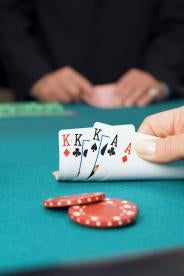The CAFC just issued a brief, but potentially far reaching, opinion in In re Ray Smith; available here.
In seven short pages the CAFC appear to have invalidated all patents directed to the gaming arts that do not utilize some form of new material objects (e.g., new type of cards or new physical playing board). The panel, Moore, Hughes & Stoll, found claims, which were directed to a variation of Blackjack, to be directed to the abstract idea of a “method of conducting a wagering game.” While this abstract idea essentially ignores all of the actual recitations in the claims, it is probably a reasonable finding. Next, the court continued by purporting to evaluate the claims under the second prong, and found that the claims here require shuffling and dealing, which are conventional activities that cannot impart an inventive concept. Here the court seems to completely ignore the aspects of the claims that would make them patentable under any section of 35 U.S.C..
Nothing in the written opinion suggests that the court evaluated (or that Applicants argued) that the “process” (e.g, the rules of the game) were the inventive concept. Why can’t the game rules be the inventive concept, other than under this new application of 101 game rules would seem to easily satisfy all other tests for patentability. Until this decision, it was my understanding that game rules, such as embodied in these claims, were patent eligible subject matter and it was the “process” or rules that were evaluated to determine patentability.
The Court did leave open a crack for some limited future innovation in this area:
That is not to say that all inventions in the gaming
arts would be foreclosed from patent protection under
§ 101. We could envisage, for example, claims directed to
conducting a game using a new or original deck of cards
potentially surviving step two of Alice.
The brief opinion, with potentially wide reaching effects, is troubling, especially when one considers how limited the remaining options for intellectual property protections appear to be for novel gaming variations based on old, well-known physical elements. Gaming rules, as such, are not protectable under copyright, since they would likely be considered functional. Rules are not protectable as trade secrets, since they have to be published to be useful to anyone. Trade dress and design patents would only be useful for protecting particular decorative aspects, but not the rules themselves.
Where does the CAFC come up with support for removing this formerly patentable area of innovation from the realm of patent eligible subject matter? Is this opinion limited by the face that these claims are directed to a wagering game, providing a link to a “fundamental economic practice”? I wouldn’t bet on future courts or litigants narrowly construing this decision.
The game rules laid out by the example claim provided in the opinion are a very specific implementation of the abstract idea of conducting a wagering game. These claims do not even remotely threaten all applications or future innovations around the idea of conducting a wagering game. At least based on the information contained within the courts opinion, this case bears very little relationship to Alice, or even the type of patents Alice represented (e.g., well known business processes performed by a computer).
Apparently the pendulum is still moving in the wrong direction!



 i
i


